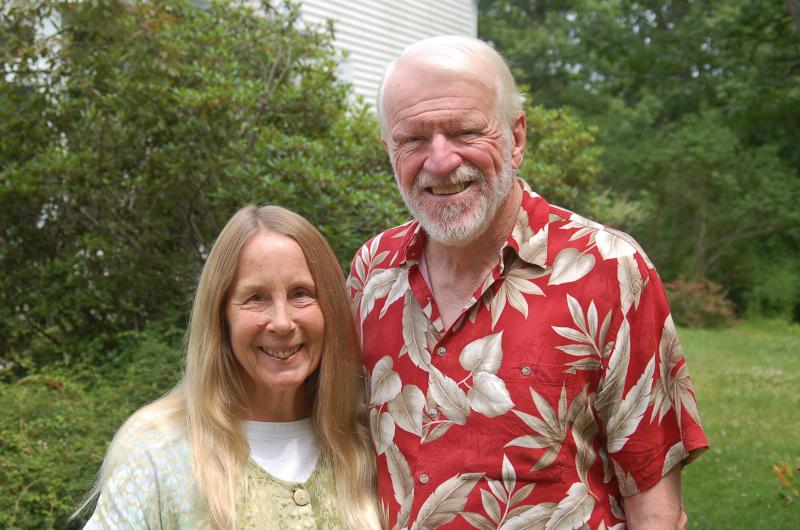Boothbay man hikes the Appalachian Trail his way
 Heidi and Peter Larsen at their home in Boothbay. ART MAYERS/Boothbay Register
Heidi and Peter Larsen at their home in Boothbay. ART MAYERS/Boothbay Register
 Heidi and Peter Larsen at their home in Boothbay. ART MAYERS/Boothbay Register
Heidi and Peter Larsen at their home in Boothbay. ART MAYERS/Boothbay Register
Every spring, hundreds of ambitious hikers attempt the 2,185-mile Appalachian Trail trek from Georgia to Mount Katahdin in Maine.
Those who plan to complete the journey within a year are called “thru-hikers.” Those who eventually endure the blistered feet and mosquito bitten faces are called “2000 milers.” Still others who do little portions at a time are called “section hikers.”
Peter Larsen of Boothbay may have figured out the best of all worlds with a system he considers unique. Early in August he will have completed the entire route without ever sleeping on the ground or carrying a 40-pound pack.
“Phooey on that,” said Larsen, a semi-retired senior scientist at Bigelow Laboratory for Ocean Sciences in East Boothbay.
When Larsen contemplated completing the route, he laid down some simple requirements. He did not want to overnight on the trail, give up his evening cocktail or a hot meal at the end of the day.
Larsen, whose trail name is “Thorfinn,” devised a scheme in which he could hike for several hours and be picked up and brought to the comforts that he found essential. He called the system “shuttle hiking” or “flip flopping.”
Although there are many professional groups that provide drop-off and pick-up services for section hikers, Larsen had a better idea. He would use his wife.
Heidi Larsen was given the trail name, “Shuttlegirl.”
The plan involved extensive research in dividing each section of the trail into doable day trips. Sometimes going south and on others north, depending on the ease of getting to his starting point.
That left Heidi with the job of getting him to the trail head and motoring around to where Peter expected to come out of the woods. In most cases that meant navigating without GPS or the use of cell phones for communication. For this spring’s southern section, the couple estimated that for 452 miles of hiking, Heidi had driven the family Buick for over 4,000 miles.
Rarely did Heidi balk at trying to use backwoods and logging roads to make the connection. On one occasion they recruited a young man in his truck to get them to a remote access point.
"There was a tree across the road. He went in his cab and got a chainsaw," Larsen said.
The job of completing the entire route was made feasible since the couple spends time in the Florida Keys in the winter and could access the southern sections on their trip back to Maine.
Larsen encountered herds of thru hikers at the trailhead in Georgia and could pick out those whose temperament or physical abilities would not allow them to complete the journey. Three out of every four eventually give it up. Although most were younger than he, Larsen takes pride that although he carries a lighter load, he was seldom if ever passed by anyone.
Larsen often shocked hikers who would see him one day going north and another going south because of his unique method.
"He got the nickname ‘déjà vu’,” said Heidi.
The couple ran across one woman hiker from Maine whose trail name was “Jingle Butt.”
"She suffered a lot," said Heidi, who said that the woman had horribly swollen feet from hiking day after day in wet shoes.
Larsen said that in spite of chronic back problems, he rarely had physical issues or encountered dangerous conditions on the trail, because unlike thru hikers, he had the option of staying away from the worst weather.
The Larsens’ plan is to mark in red the final two uncompleted sections of the trail map sometime in early August, i.e., the section between Monson and Caratunk and the infamous Hundred-Mile Wilderness trail that leads to the base of Mt. Katahdin.
Part of the time Larsen plans to have a companion, his grandson, Gus, and possibly a crew of friends to meet him at the end of his journey.
Typical of his penchant for planning and securing his daily comforts, he will break the final leg into four or five day trips. The Wilderness trail has destroyed many hikers with its constant marshy bogs and incessant mosquito attacks.
Heidi said that comparing her anxiety for her husband’s hiking to his other hobby as a race-car driving instructor, that she is far more worried for him on the trail than watching him speed around a track at 100 miles an hour.
Related: More stories on locals hiking the Appalachian Trail
Event Date
Address
United States























